These easy vegan biscuits rise beautifully and they are flaky, fluffy and buttery. The recipe riffs off a classic buttermilk biscuit recipe without the buttermilk and it guarantees the best biscuits you've ever baked. Also included are instructions for making these gluten-free.
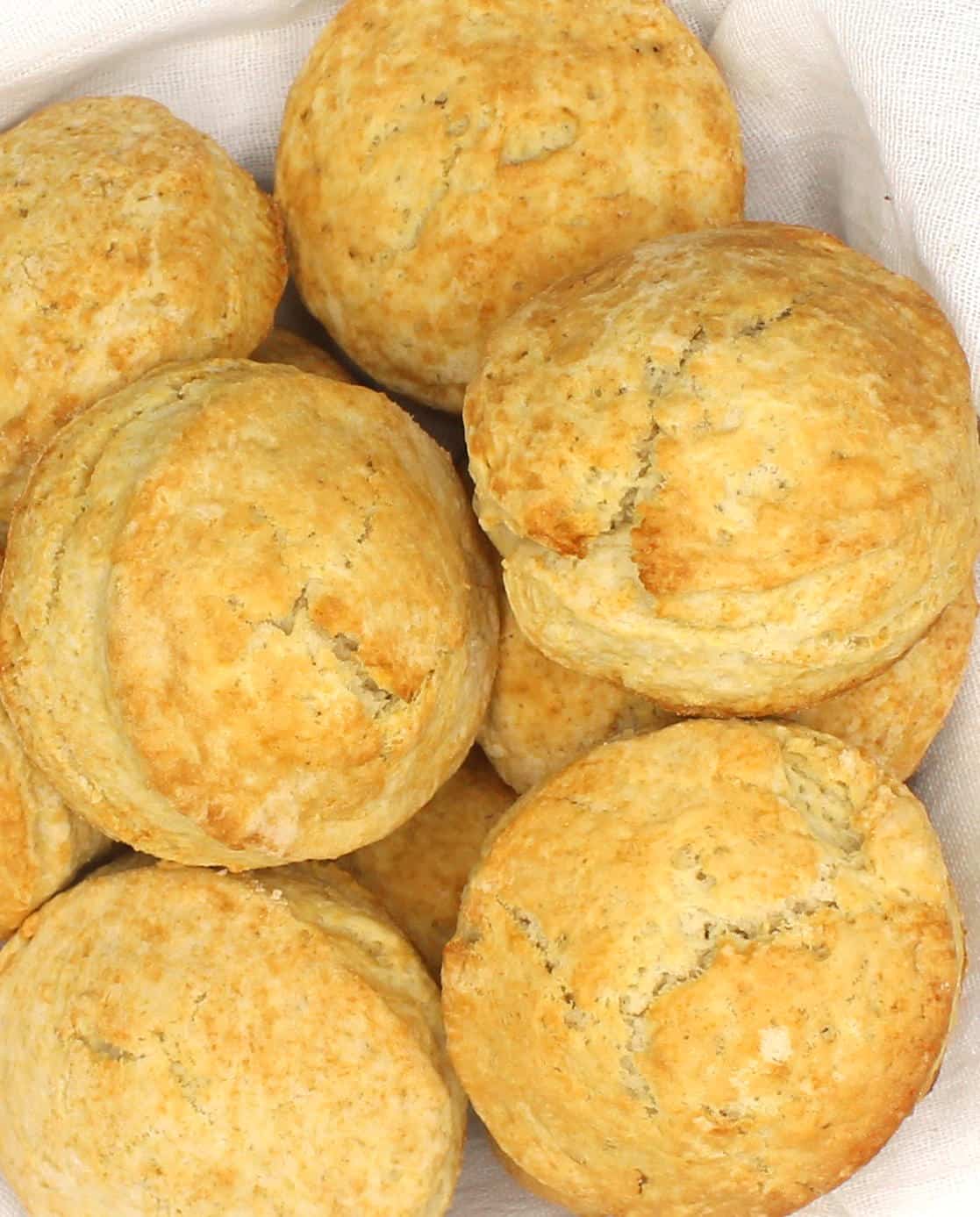
Homemade biscuits are a beloved American food, and a much-requested one in our home as well (including vegan buttermilk drop biscuits and vegan sourdough biscuits). The biscuits I make most often, however, are these simple but classic vegan biscuits.
This recipe is simply amazing. The biscuits come together really quickly, so they're perfect for when you're in a hurry or when you have guests over. And they need just six ingredients, most of which almost certainly are in your pantry.
They are also utterly easy to make, with a few caveats to keep in mind that I will share, so you can make the most delicious homemade vegan biscuits ever.
Table of Contents
Why you'll love these vegan biscuits
- Fluffy and melt-in-the-mouth tender. These vegan buttermilk biscuits are so perfect and they will elicit rave reviews from anyone who is lucky enough to eat them.
- Six ingredients and one bowl (or food processor) needed. This vegan biscuit recipe is so simple, and once you have the biscuits cut out they take just 14 minutes in the oven to bake up into perfect, fluffy deliciousness.
- Versatile. You can serve these biscuits for any meal. They make a delicious addition to a vegan breakfast or brunch and you can also serve them for lunch or dinner, or eat them all by themselves--they are so good!
Tips for success
- With biscuit dough, as with pie dough, you want to handle the dough as little as possible, so work quickly. A winter kitchen is friendlier to making biscuits because ingredients remain colder for longer. Keep all wet ingredients, including the milk and butter, refrigerated until ready to use.
- Use a fork to mix your dough. Your hands are warm, and warmth is not good until the time the biscuits hit the oven. You will need to touch your dough a few times, while putting it in cling wrap or while rolling it, and that's fine. Just don't do all of the mixing with your hands.
- Refrigerate the biscuit dough for at least five minutes before cutting out biscuits.
- When you cut the biscuits, flour the cookie cutter lightly and don't wiggle it into the dough as you cut--cut straight down in a decisive motion. This will help the biscuits rise better, with flaky layers.
- Roll the biscuit dough on a lightly floured surface. You want enough flour to keep your dough from sticking, and you should also flour your rolling pin as well as scatter a bit of flour on top of the dough to make rolling easier.
- Round biscuits are classic, but you can also use a square or rectangle cookie cutter, if you like.
Ingredients
- Unbleached all-purpose flour. You might be tempted to substitute whole wheat flour here, and you can, but you will get the most tender, most fluffy biscuits with all-purpose flour.
- Baking powder + baking soda. These will help the biscuits get fluffy and rise a mile high.
- Vegan butter. This will help make the biscuits flaky but soft. You can use any vegan butter, including Earth Balance, Miyoko, Country Crock or one of the many others now in the market.
- Non-dairy milk. I used oat milk. Use any dairy-free milk of your choice, including almond milk, soy milk, cashew milk, etc.
- Apple cider vinegar. This, along with the milk, will create a buttermilk-like chemistry that makes the biscuits flaky and fluffy.
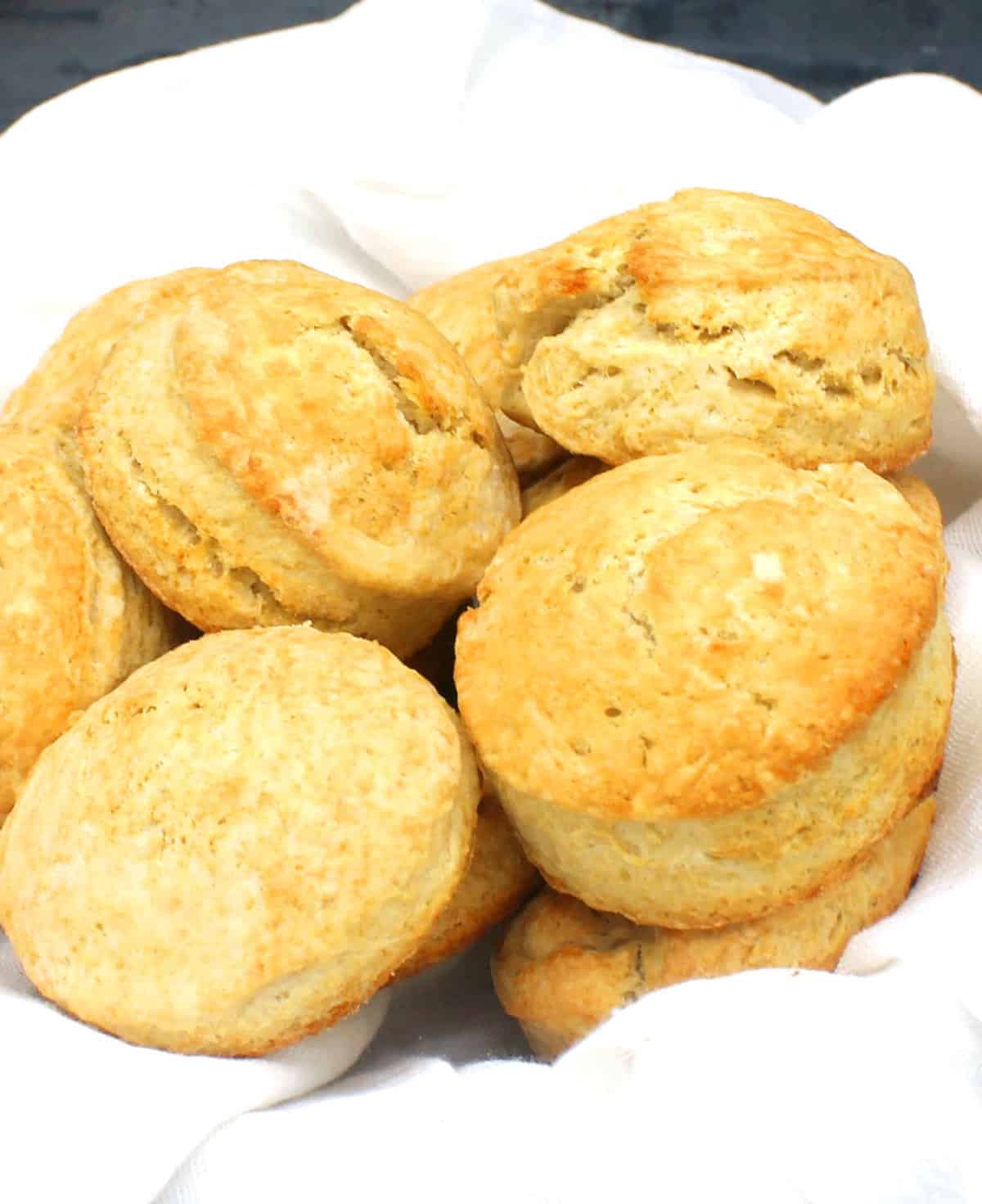
How to make vegan biscuits
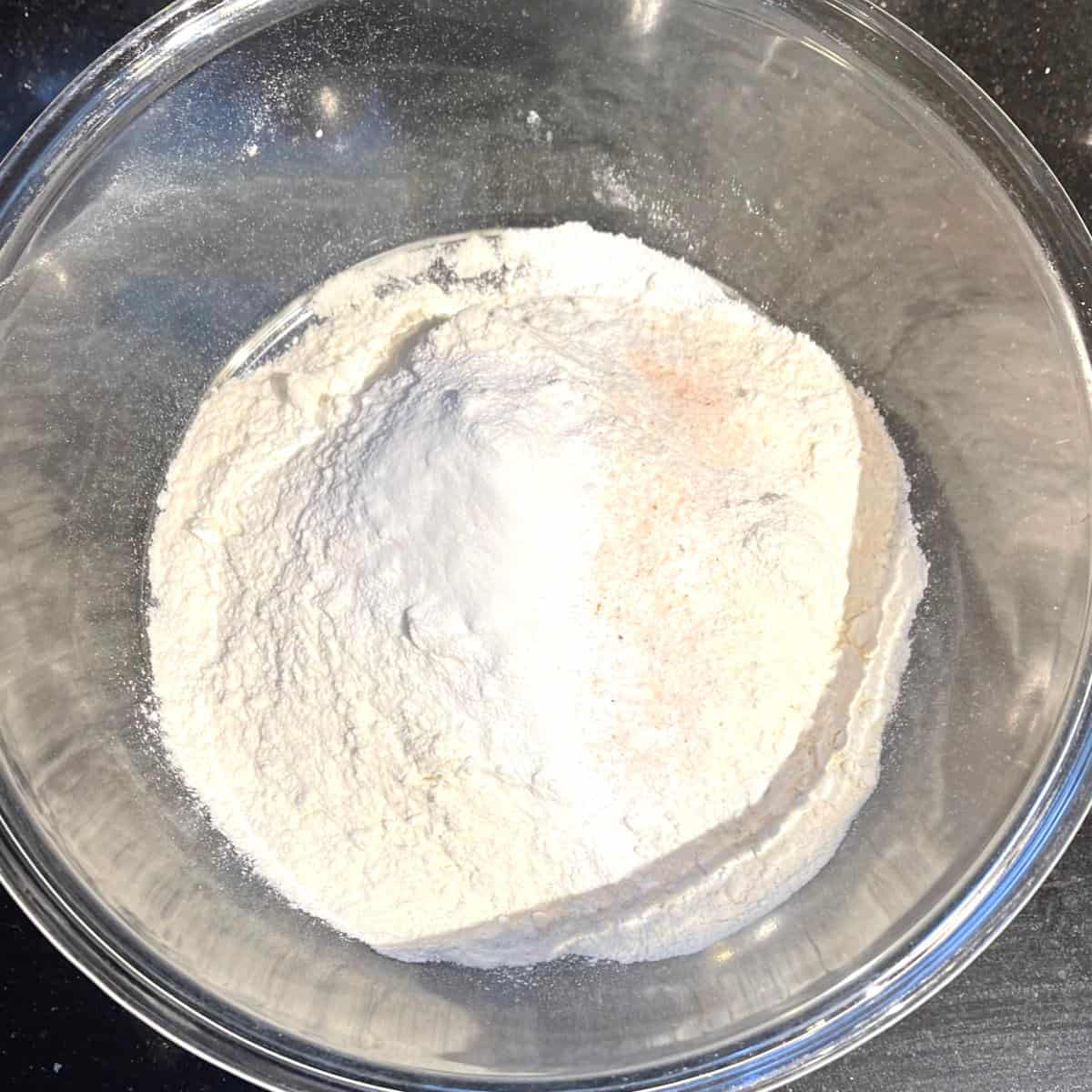
1. Mix the non dairy milk with the vinegar and set aside in the refrigerator for a couple of minutes to curdle. This is the vegan buttermilk.
Place the flour in a bowl with the baking powder, baking soda and salt. Whisk together.
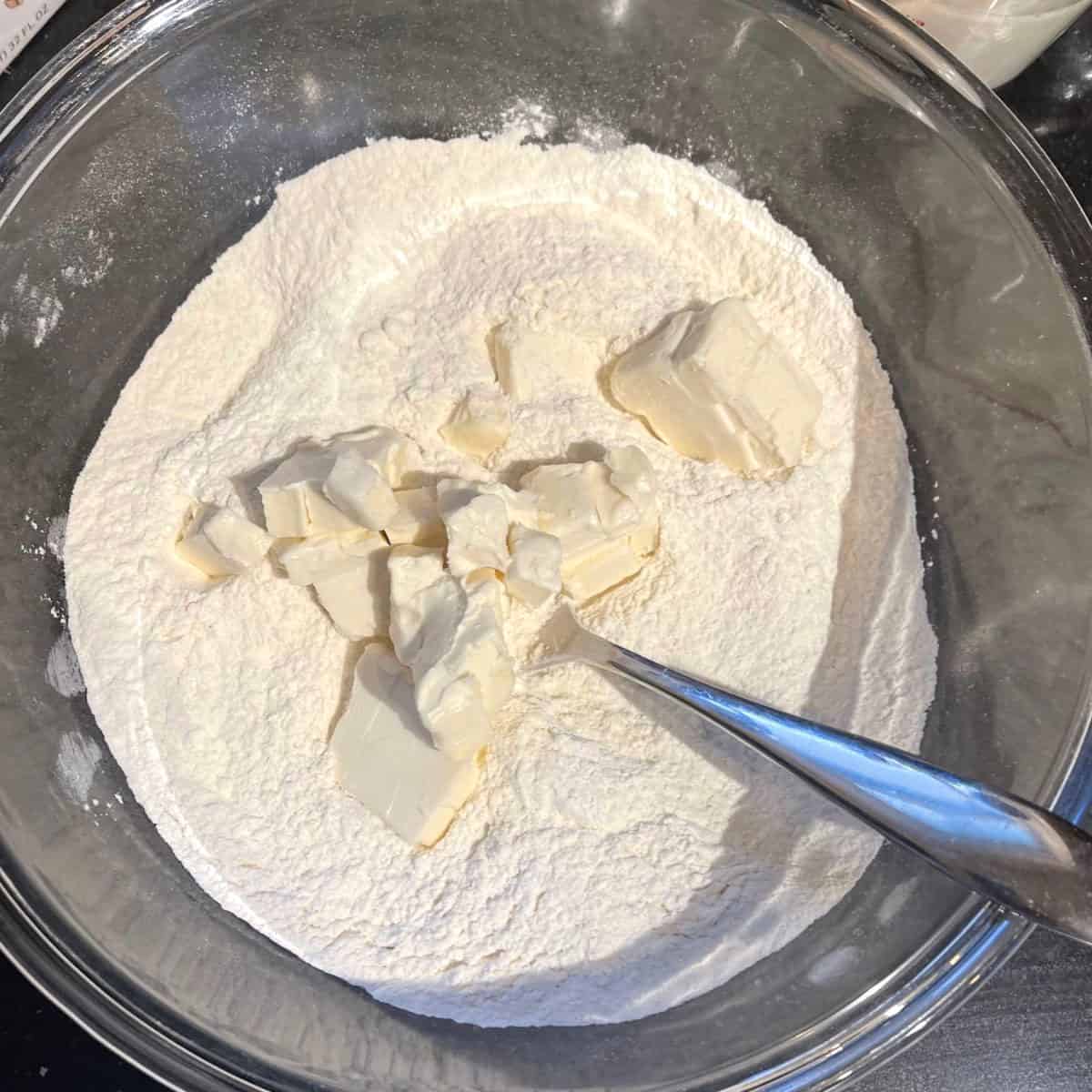
2. Add the cold vegan butter to the bowl with the dry ingredients and, using a fork or a pastry-cutter, "cut" the butter into the flour until you have a coarse mixture with a few pea-size pieces of butter. You can also do this in the food processor--pulse the flour and butter three to four times, for five seconds each time, no more, until the butter has broken down into smaller bits.
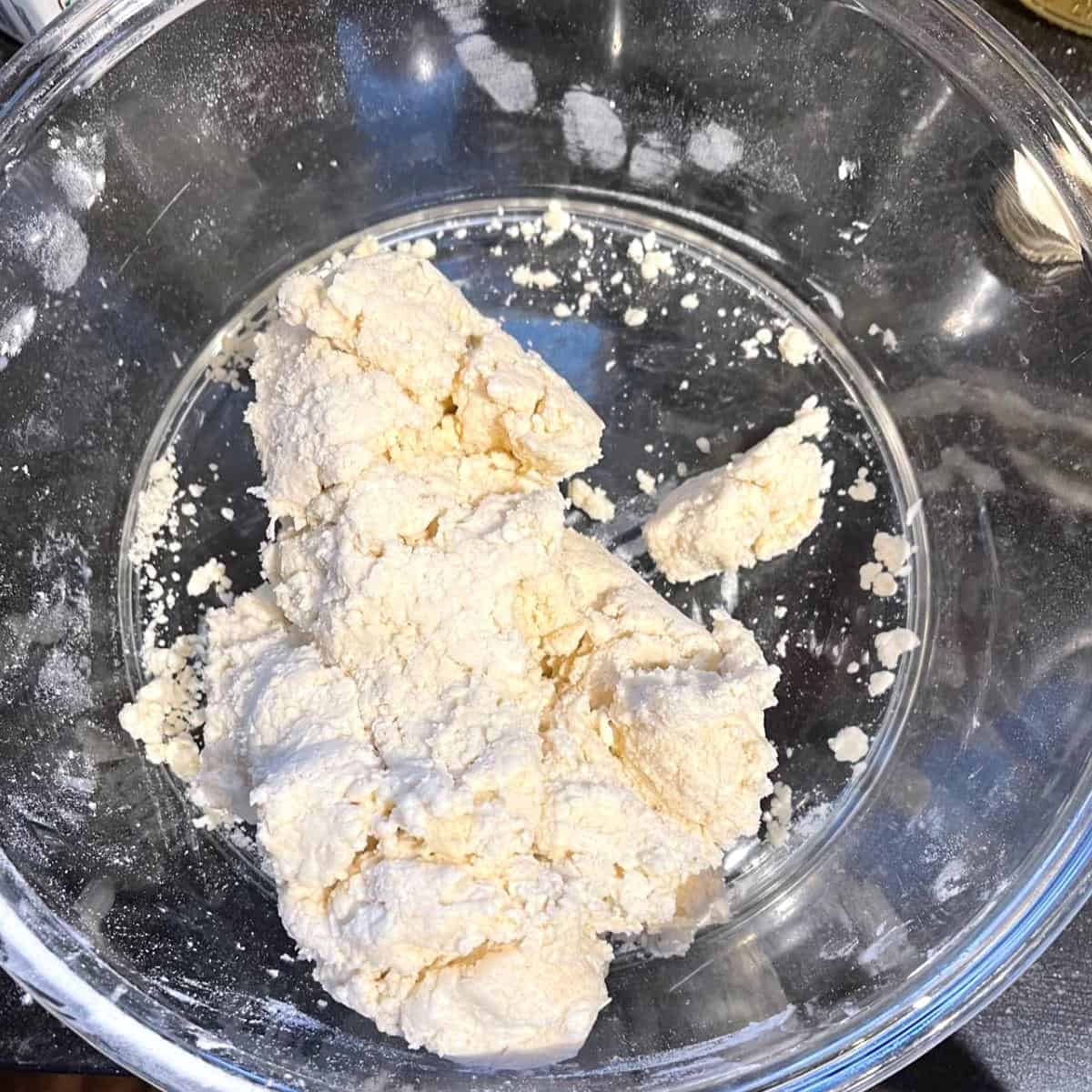
3. Slowly drizzle in the nondairy milk and vinegar mixture, and mix with a fork until the dough forms. If doing this in the food processor pour the milk through the feed tube while turning on the "pulse" button in short bursts. You may not need all of the milk. The dough should be moist enough to come together in a ball, but it should not be too wet.
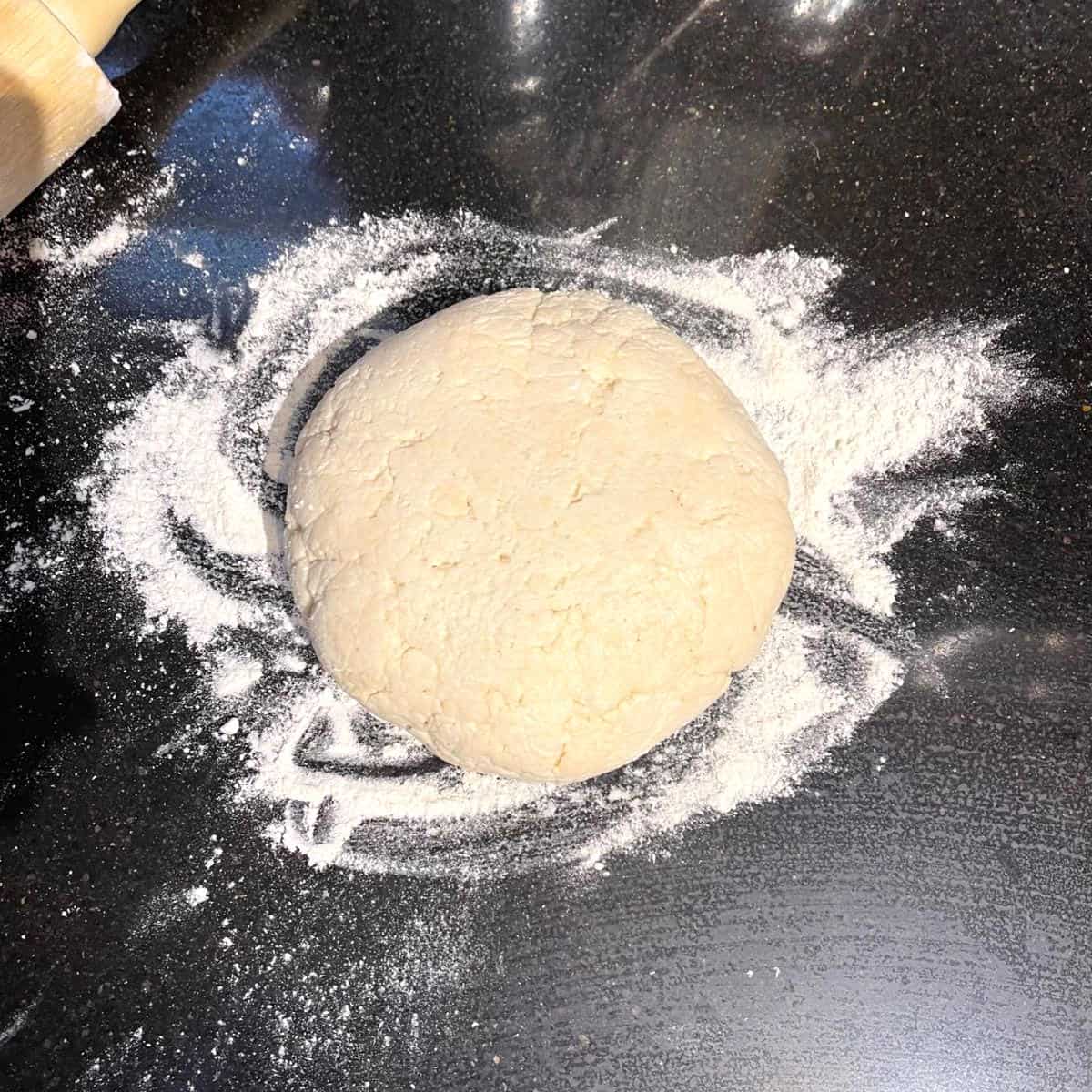
4. Wrap the biscuit dough in cling wrap, flatten into a disc, and place in the refrigerator for at least 5-10 minutes. Meanwhile, set the oven to preheat to 450 degrees Fahrenheit/230 degrees Celsius.
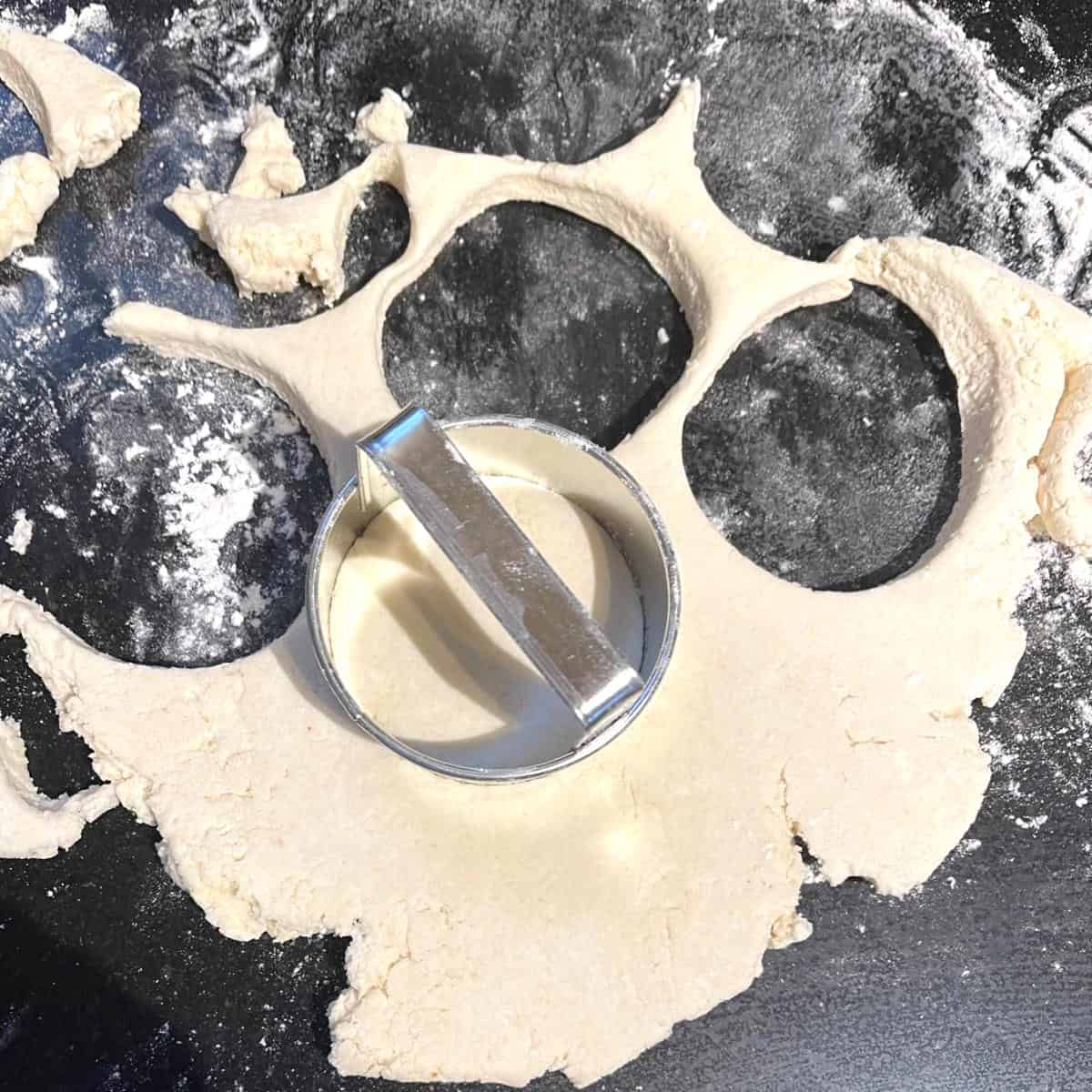
5. On a floured surface, roll out the dough about ½-inch thick. Use a round cookie cutter to cut out biscuits. Roll up dough scraps and cut more out. You should get about 10-12 biscuits.
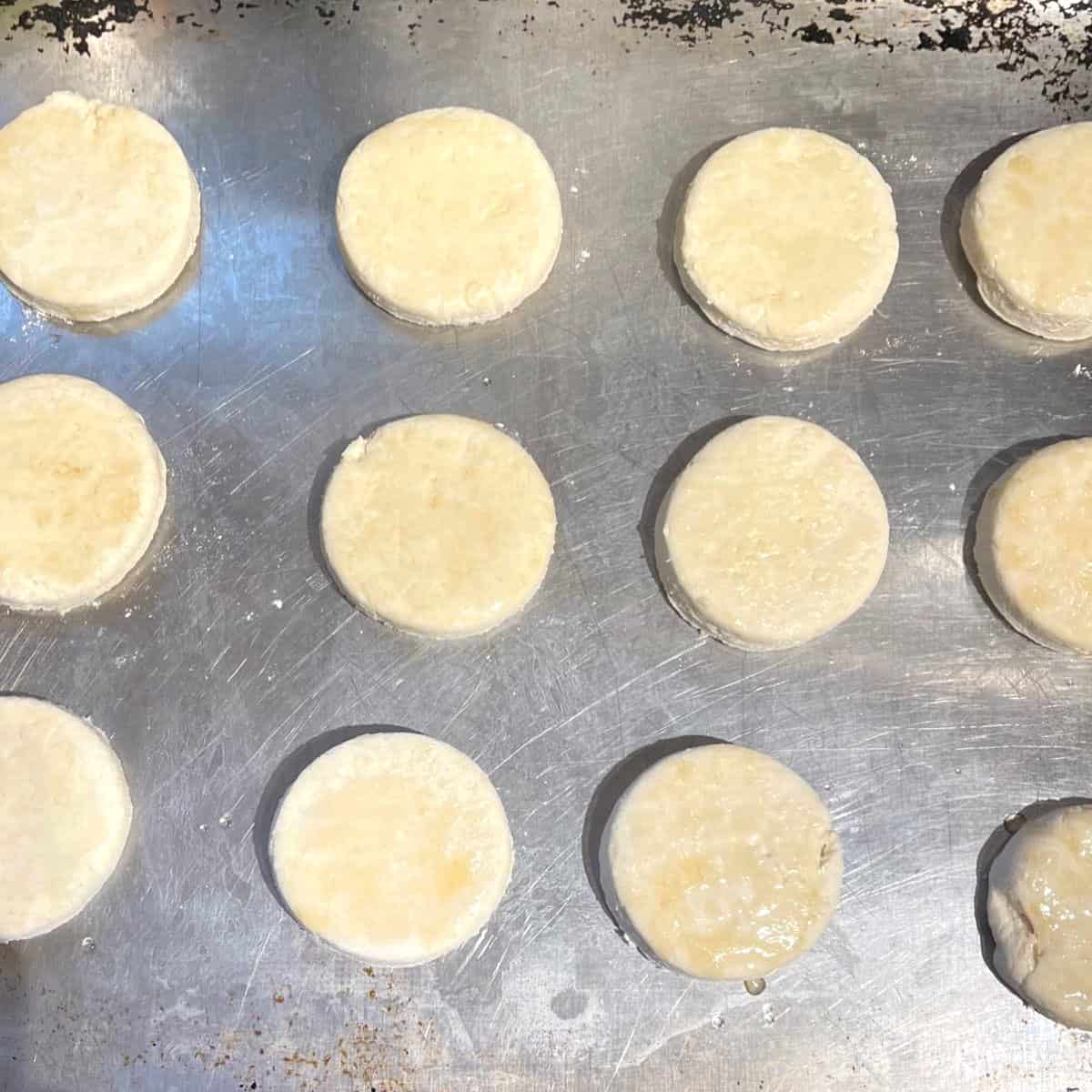
6. Place the biscuits at least an inch apart on a baking sheet. You can brush a mixture of one teaspoon oil with one teaspoon non-dairy milk on the biscuits to help them color. Bake for 14 minutes until fluffy and golden brown.
Recipe FAQ
Use two cups of gluten-free all purpose flour and a tablespoon of tapioca starch or tapioca flour. You can also add ½ teaspoon of xanthan gum, if the flour doesn't already have some added to it. Proceed with making the dough as instructed. You might need more milk, because gluten-free flours tend to be thirstier. Once you have a dough, pat it into a circle half-inch thick on a floured surface using your hands, not a rolling pin. Bake the biscuits for 18 minutes. They won't be as golden-brown as biscuits made with all-purpose flour, but they will taste amazing.
You can, but biscuits made with wholegrain flour won't be quite as fluffy. But if you want healthier biscuits, go for it.
My family loves these for breakfast with vegan butter and raspberry jam. You can also serve these with a side of vegan scrambled chickpea eggs, or at lunch or dinner with a vegan meatball fricassee or a vegan mushroom gravy or a vegan beef stew.
Storage instructions
- Refrigerate: Refrigerate leftover biscuits for up to four days.
- Freeze: Flash-freeze the biscuits on a baking sheet in the freezer. Then place in an air-tight container or freezer-safe container and freeze for up to four months.
- Reheat: Heat refrigerated biscuits in a 350-degree preheated oven for 4-5 minutes or until warmed through. If reheating frozen biscuits, reheat 10-12 minutes, no need to thaw first.
More vegan bread roll recipes
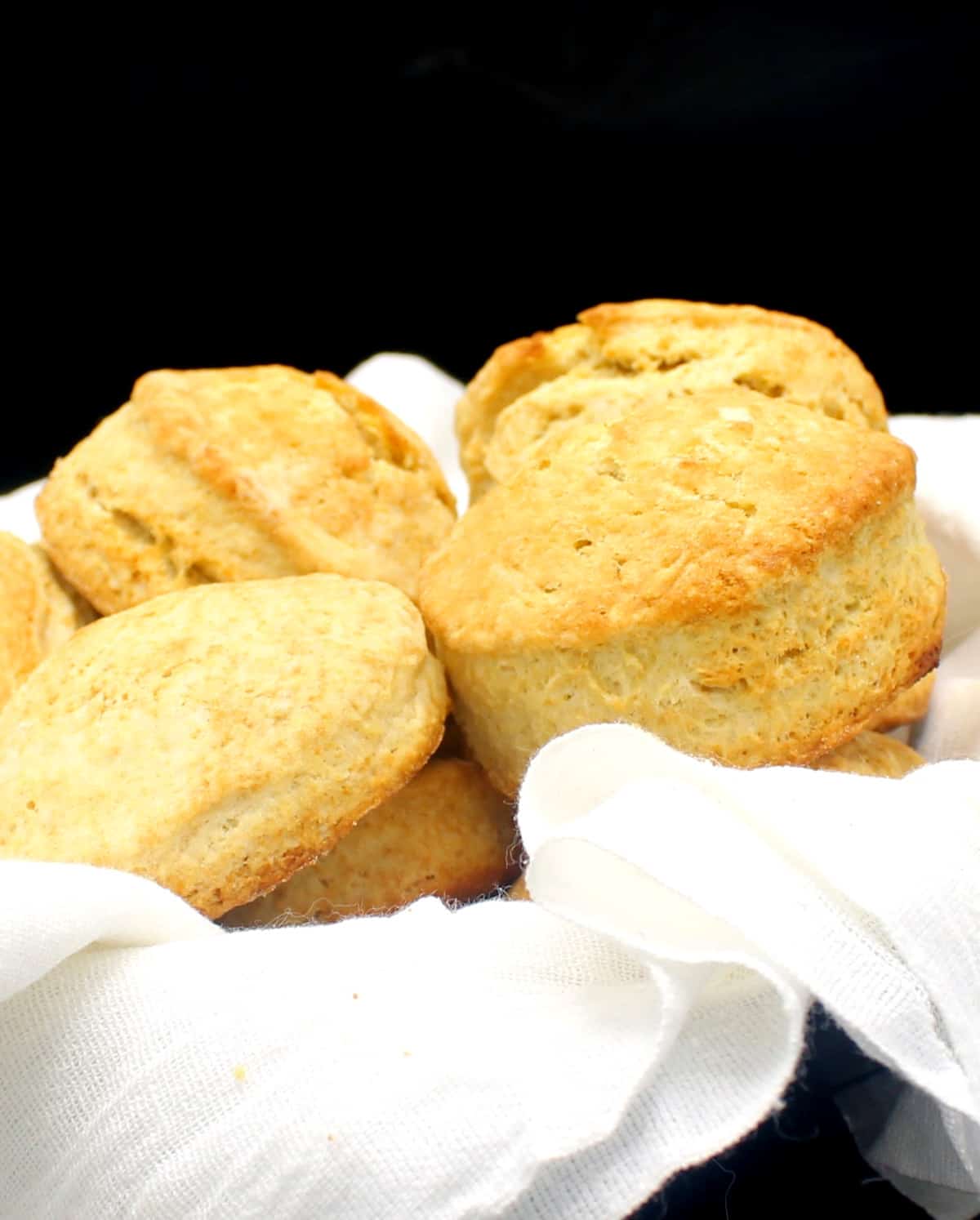
Did you make this recipe? Leave a review and a star rating below or tag us on Instagram! Thanks!
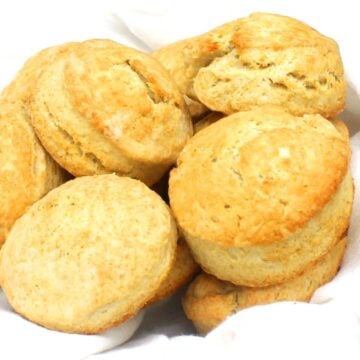
Vegan Biscuits
Equipment
Ingredients
- 2 cups unbleached all purpose flour
- 2 teaspoon baking powder
- ½ teaspoon baking soda
- ½ teaspoon salt
- 6 tablespoon vegan butter (very cold, straight from the refrigerator. Cut into small cubes just before adding to flour)
- 1 cup non-dairy milk (cold, straight from the refrigerator. I used oat milk),
- 1 teaspoon apple cider vinegar
Instructions
- Mix the non dairy milk with the vinegar and set aside in the refrigerator for a couple of minutes to curdle.
- Place the flour in a bowl with the baking powder, baking soda and salt. Whisk together.
- Add the butter to the bowl and, using a fork or a pastry-cutter, "cut" the butter into the flour until you have a coarse mixture with a few pea-size pieces of butter. You can also do this in the food processor--pulse the flour and butter three to four times, for five seconds each time, no more, until the butter has broken down into smaller bits.
- Slowly drizzle in the nondairy milk and vinegar mixture, and mix with a fork until the dough forms. If doing this in the food processor pour the milk through the feed tube while turning on the "pulse" button in short bursts. You may not need all of the milk. The dough should be moist enough to come together in a ball, but it should not be too wet.
- Wrap the biscuit dough in cling wrap, flatten into a disc, and place in the refrigerator for at least 5-10 minutes. Meanwhile, set the oven to preheat to 450 degrees Fahrenheit/230 degrees Celsius.
- On a floured surface, roll out the dough about ½-inch thick. Use a cookie cutter to cut out biscuits. Roll up dough scraps and cut more biscuits. You should get about 10-12 biscuits.
- Place the biscuits at least an inch apart on a baking sheet. You can brush a mixture of one teaspoon oil with one teaspoon non-dairy milk on the biscuits to help them color. Bake for 14 minutes until fluffy and golden.
- Serve hot or warm.
Notes
- Use two cups of gluten-free all purpose flour and a tablespoon of tapioca starch or tapioca flour. You can also add ½ teaspoon of xanthan gum, if the flour doesn't already have some added to it. Proceed with making the dough as instructed. You might need more milk, because gluten-free flours tend to be thirstier. Once you have a dough, pat it into a circle half-inch thick on a floured surface using your hands, not a rolling pin. Bake the biscuits for 18 minutes. They won't be as golden-brown as biscuits made with all-purpose flour, but they will taste amazing.
- Refrigerate: Refrigerate leftover biscuits for up to four days.
- Freeze: Flash-freeze the biscuits on a baking sheet in the freezer. Then place in an air-tight container or freezer-safe container and freeze for up to four months.
- Reheat: Heat refrigerated biscuits in a 350-degree preheated oven for 4-5 minutes or until warmed through. If reheating frozen biscuits, reheat 10-12 minutes, no need to thaw first.

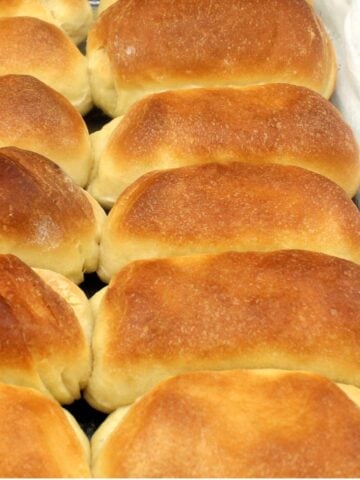
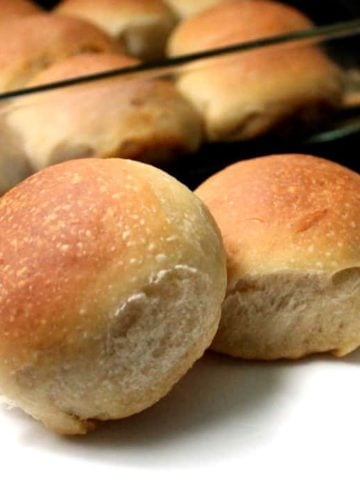
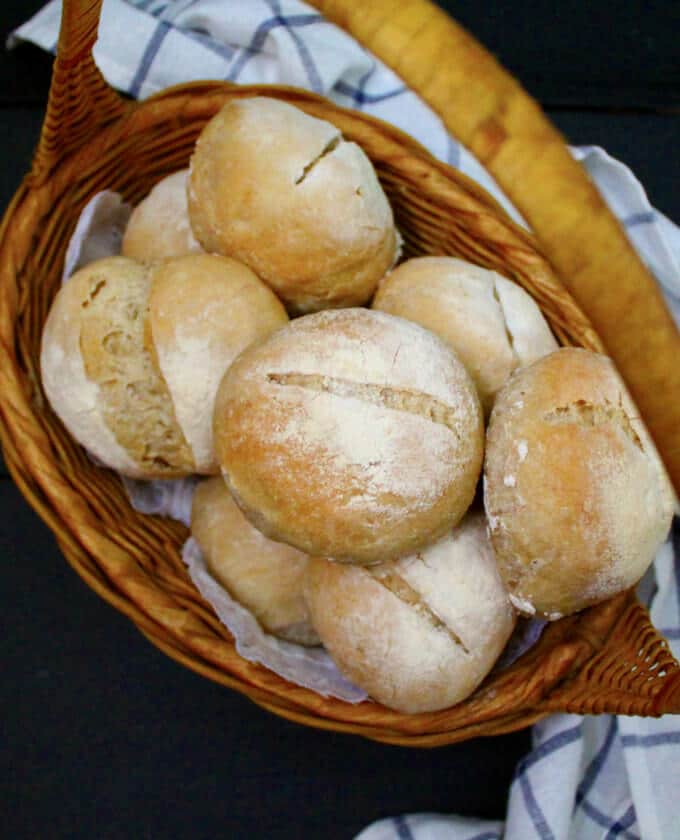
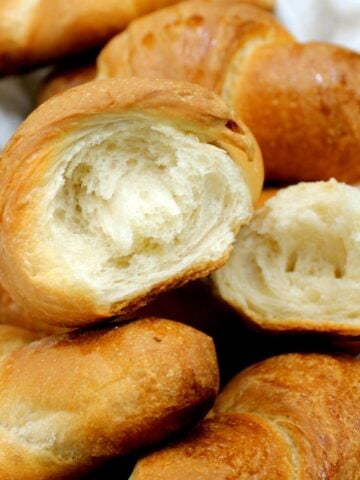
Angel & Paul M.
Thank you for such detailed instructions. While I’m working my husband is going to make these for me because your great directions.
Anonymous
-Thank you!
jacquie
HI - the recipe looks good and i'm looking forward to trying it. I do have one question though as to why the number of biscuits/serving is so different for these compared to your buttermilk ones when the same amount of flour is used. thanks.
Vaishali
Hi Jacquie, it's just the size of the biscuits. You can make them bigger or smaller for more or fewer servings.
Moki
Hello, I have a friend who has just figured out that she has an unpleasant reaction to xanthan gum. Are there any alternatives? Tnx
Vaishali
Hi Moki, skip the gum.
Melissa
I made the gluten free version of these biscuits this morning, right after finding the recipe. They are yummy. They are moist and soft on the inside with a slight crisp to the outside. I followed the directions exactly. I put the dough in the freezer before baking. The only thing keeping it from being a 5 star rating is that the biscuits did not rise very high. I don't know if that's a GF thing or what. It didn't take away from the taste though.
Ann
Could you sub cold coconut oil for the vegan butter?
Vaishali
Yes! Refrigerate it first so it's really firm.
Lucy
Thank you for this recipe. Turned out great!
Hubby and kids liked the biscuits as well. 😉
Vaishali
So happy you made the biscuits, Lucy!
Sharmi
Hi, I am new to the vegan and dairy-free world and love your recipes. I have a question. Have you tried using any gluten-free flours? If yes, what would you suggest?
Vaishali
Hi Sharmi, I tried a gluten-free version of these last night using King Arthur measure for measure which is the gf flour I usually use. It already has xanthan gum added. I have included instructions for making the biscuits gluten-free above, both in the tips section and within the recipe. Hope that helps.
Leslie
Has anyone tried these using all-purpose GF flour? My friend's husband has celiac disease, and as a Southern girl born and bred, she really misses biscuits.
Vaishali
I made a gluten-free version of these last night, and have included the instructions within the recipe, with additional tips above. These turned out delicious.
Anonymous
These were awesome. Best biscuits ever ! I read on some other blog to fold the dough over a few times to make them flaky and turned out perfect.
Anonymous
Baked these a few days ago...something told me it seemed like a lot of baking powder, but I shrugged it off given the other reviews. When they came out, they smelled like baking powder and were bitter. Not willing to give up, I used 1/2 a teaspoon less baking powder than your recipe calls for the next time I made them. This time, they were light, fluffy, savory, and tasted great. No baking powder smell. Wondering if anyone else experienced the baking powder bitterness when they made these.
Phyllis
2 teaspoons of baking powder is the amount traditionally added to 2 cups of flour for biscuits whether vegan or not. I have my grandmother’s biscuit recipe from the early 1900’s & this is what she called for so it’s what I’ve always used. I have found, though, that not all baking powders are the same. I typically use Rumford aluminum free but decided to try Backer’s Cream. The Baker’s Cream gave me that same smell & taste you described so I had to cut back on that one. But Rumford, my go to, I keep at 2 teaspoons. I’m not sure if there are other baking powders out there but something to consider.
Unknown
Hey, loved your bean and oat burger recipe!! THank you!
Unknown
Hey, accidently came upon your site when i was looking for bean burgers. Thank you, tried them out and loved them absolutely............
Anonymous
This is hands down the best vegan recipe site ever! Keep it up girl you're awesome,
Kirsten Lindquist
Just made these - simple and fabulous! Thanks for sharing